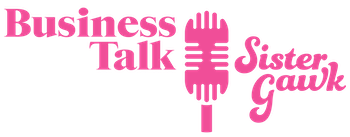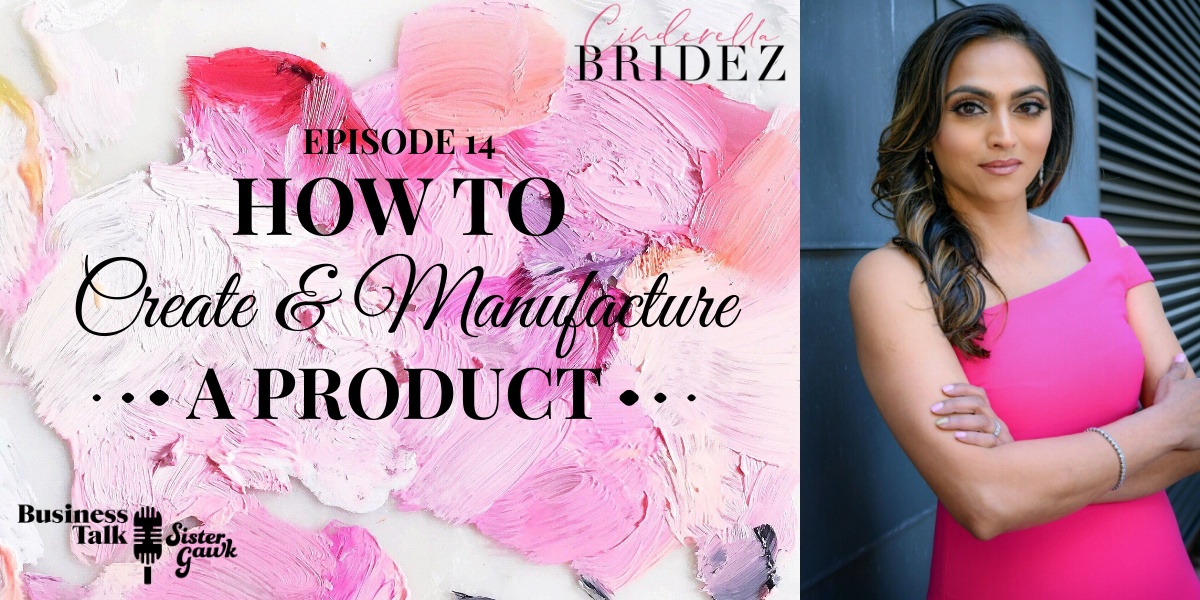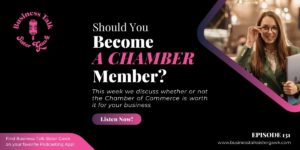This week, we get the exciting opportunity to interview Barbie from Cinderella Bridez about how she went through the process of creating and manufacturing a product that she is currently selling in the United States. You are going to fall in love with this fantastic entrepreneur and her spirit to get up and keep going every day. From international manufacturing to minimum order quantities, this woman is a wealth of knowledge to anyone who is looking to launch their own product based idea!
Bekkah: I am super excited to tell you about this lady. She is a wealth of knowledge and I have seen so many interesting things so far and picking her brain. I am super excited to welcome Barbie! Thanks so much for being here! Can you tell us a little bit about what you do?
Barbie: Absolutely, thank you guys so much for inviting me on our show today! I’m super excited to share. I love the initiative you have with helping young entrepreneurs get started and learn processes for how to start any type of business. For me, I own multiple different businesses but what I’m going to talk to you about today is how I brought and how I basically formulated, branded, and launched my own haircare line. We just have two products right now. It’s really exciting just to be able to see an idea that you had for so long come to fruition. I’m going to talk to you about the manufacturing process.
How Did You Start A Business Inventing a New Product?
Bekkah: Can you tell us why you started this? Where did it come from? What was your inspiration to invent it?
Barbie: Absolutely. My background is Asian Indian, and growing up I had very, very fond memories of my grandmother massaging hair oil into our hair. I used to have really long hair. Nobody likes greasy hair. As I started growing up, I really got away from that but what I noticed was that the Native women that live in India, they had thick, long hair for years. They were the same age as me or older and they had an abundance of hair. In India the common practice is hair oiling which is done regularly, a multiple times a week basis. They’re basically putting all these good nutrients from these rich organic Ayurvedic oils into their scalp and then just washing it out. Or some of them leaving it in as an overnight treatment, but what was available to us here in the States was just very greasy or not smell that great.
My background is in the beauty industry, I do professional makeup and hairstyling. I’ve had that business for over 14 years, hence Cinderella Brides. I’ve seen a lot of my clients have hair loss and I thought that there has to be a solution. Pills are great and there’s all these extensions and stuff but why does everybody need that when they can start from the root of it all. If one country is experiencing an abundance where we’re experiencing lack, what’s the difference? Quite frankly we can get into so many details of what it could be but I knew that one of the practices, hair oiling, was something that I could bring to the states and make it an easy, simple and pleasant type of experience versus some of the products that we have available here today. That’s what inspired it.
How to Scope Out Your Product Manufacturing Competition
Bekkah: How did you go about doing that? Was there competition you were scoping out? Did you compare yourself to anyone else or did you just do it?
Barbie: First I looked at all the different brands in the US. When I went into Target or any type of department store or a drugstore where they sold haircare products, the first thing I noticed that there was nothing Ayurvedic. The second thing I noticed as I started doing my online research even online when I searched all the major websites like Amazon, there wasn’t a lot of us options. A lot of everything that was sold was basically imported from India. I started looking at the top-selling brands in India that were sold here and the ones that moved.
I basically decided that l I can formulate something. The key was to have something that was more of a treatment so that people don’t have to feel like they’re walking around with oily hair. The second thing was to have really, really good ingredients that would give the results. The third thing was to make sure the product smells good. I scoped out brands and different competitors. Then I actually contacted a factory in India through recommendations. At the time my brother was living in India so he was able to find different factories but that information if you just google is available online. You can find any manufacturer anywhere in the world if you wanted to.
Ruthie: Tell us what the, I’m going to mispronounce it but the Ayur- Aryeedic?
Barbie: Ayurvedic. It’s basically an ancient Indian practice of taking natural herbs and things that are organic and putting together different ingredients. Turmeric is an Ayurvedic ingredient. For us our ingredients in the hair oil is the Amla. That’s an Ayurvedic ingredient that is an Indian plant. We have Bhringaraj which is an Ayurvedic ingredient. We basically experimented. I contacted the factories and we started going back and forth on WhatsApp. The means of communication was WhatsApp. They were very, very quick to get back to us. That’s how you know when you’re picking a manufacturer to work with. The things that you want to be aware of and be mindful of is number one can you properly communicate with them. Do they properly understand you? Especially if you’re dealing with international manufacturers you want to make sure that there is a clear stream of communication.
Know How You Are Going to Communicate With Your Manufacturer
Number two is what platform are you going to talk to them on? Number three is what their response time is. Because the response time was great with this factory that we were going to possibly manufacture with, we went back and forth. I went through their catalog. I identified some of they’re already in-stock products that were the oils that I wanted to try. Then some that we asked, “Can you take this out? Can you take this out and give us a sample formulation?” And they did all that. I ordered the samples. I paid for them via PayPal and they sent them via airmail. Then I had a whole bunch of different products that I can try out and test out. I tested shampoo. I tested leave-in conditioners and sprays. I really identified what I wanted to with because I’m a new business and a small business, I wanted to first you know grow to scale. I basically started with two products and we got the formulations the way we wanted and then we went into packaging.
Ruthie: How much of that was your own experimentation and how much of that was something that they had already produced themselves?
Barbie: I guess 50/50. They had a formulation that we liked. We liked the smell of it. What I wanted to do was really streamline it and put only a certain amount of oils. Take out the ones that I didn’t think were actually relevant and also add hemp. Hemp is really, really great for retaining moisture in the scalp and in the strands of the hairs. Being in a country that we’re more north than India, I wanted to have something where we would be able to have a little bit more moisture. One of the problems that I’ve seen is dry hair and breakage in the hair. That’s something that we included. Thinking from a marketing and a “what’s hot right now?” prospective, hemp, CBD all those product ingredients are blowing up right now. That’s why we formulated it in a way that it included things that we knew would be a good seller.
How Do You Navigate Customs When Importing Goods to The US?
Bekkah: You started ordering and you thought, “Alright, I’m ready to do this.” How did that work with customs and importing and trying to navigate all that? Was there approval processes you had to go through to sell to North America?
Barbie: Absolutely it’s not an easy process. I will tell you, you have to be patient. Before we imported, we had to come up with the brand name and labeling. I had a designer go back and forth. My brother was in the process too because he initially started out with me. This was something he was helping me with because he was living in India at the time. We went back and forth with the designers. We tried to identify different brands, what colors, what scheme, and once that was done and the product was ready to ship, they shipped it. But it came and had to hire a customs broker to release it from the airport, once. That was a process!
It took a couple of days because it was my first time doing that and I didn’t realize what it entailed initially. Even when you get any type of products shipped from another country it really depends on what the product is. This is considered a topical product. Depending on what you’re manufacturing, it might have to go through customs. Especially how your factory ships it. So you have to be specific in how and where you want it to be shipped. I had to hire a customs broker. We had to go through paperwork and verification.
Then we finally had the product and their product needed to get verified because right now the primary source of where the product is being sold is on Amazon in the US. I had to apply for a seller certificate for topical products. They had to see what the products look like. They had to confirm if we had a UPC code. Are we the manufacturer. They wanted proof of all that. We had to take pictures and upload everything. Then it took a couple of days to get verified but once you get verified then you can ship the product out to Amazon. They send you a prepaid label and that goes along with your seller’s account. Then I shipped everything to them. Then it’s all marketing.
You’re thinking, “Okay, now I have a product amongst a billion other products online. How do I differentiate myself?” That’s in itself making sure you’re creating the strong graphics for it. Making sure you’re creating really great value statements of why people should purchase. Also paying for advertising right on Amazon. Typically when you launch your first products don’t expect 100% profit because you’re going to want to reinvest everything that you make into your marketing and your advertising for that product.
How Do You Get UPC Codes For Your Product?
Bekkah: I have not looked a ton into the UPC codes, but I’ve heard that it can be really difficult. Did you have to find someone to do that or did you do it yourself?
Barbie: There is actually a company that you can apply and get the codes. You pay for it then you’ll get the codes and you can have them printed on your packaging.
Ruthie: When you started out, did you go straight to Amazon or did you try other selling sites? What made Amazon stand out to you the most?
Barbie: When we first started and I got the initial shipment I knew we have had product businesses in my family. My brother has launched other products before. He had connections for me that he had the buyers of Meijer, Walmart, Sally’s Beauty Supply, and CVS. Initially when I got the product, I mailed it out to all the different buyers like Macy’s backstage.
How to Get Connections to Buy Your Product for Retail Sales
Let me take a step back to the way that we even got the connections. If you’re looking to sell into retail go on LinkedIn, pay for the premium account, and start to search for buyers. Specifically the purchasing department or buyers for specific brands or companies that you want to sell to. That’s where you’re going to be able to send a sample of your product. The buyer actually evaluates the product and sees if it would be a good fit. Initially, we sent it to a lot of the buyers but I got the product in November the timing was around Christmas and January. It didn’t get the attention that it needed. We also got feedback from buyers on certain things about what they would like to see in their market. One of them said the package of the individual oil needed to be bigger. We did get some offers from two different buyers, but what they wanted to pay for the product was less than what would be worth our profit margin.
We decided to go against it and turn to Amazon for selling for now. It’s still in an evolution stage so we are still going to make tweaks for the second order, the second batch of product. That’s how you start.
Anybody listening to this podcast, if you have an idea, you just need to start. You just need to figure it out and start. Do it. You’re going to make mistakes along the way.
Most people have that anxiety of not making it perfect so they never launch. I think that’s a big mistake because you can always tweak and refine as you go along in every step of your process. I love the saying, “Rome wasn’t built in a day, it was built block by block by block” That’s the building block of starting and a creating product. Some products are going to be super successful and some are not. Be prepared for failure. You’re going to have to keep trying again and again until you get to the level that you deem for yourself a success.
How To Stay Motivated While Trying to Launch A Product
Ruthie: How did you stay motivated throughout all of that? Because it sounds like it’s one hill after another as you’ve been pursuing this. Your brother was super helpful in that and he figured out a lot of things, but you did so much of the groundwork and having to navigate so much. How did you stay motivated throughout all that?
Barbie: For me, I have multiple different avenues of how I build my businesses. Just because one wasn’t going the way I wanted I was having success somewhere else. As far as the process, you’re just focusing on building on brand. You have to set your long-term goals. Then you have to make sure that you keep a positive mental attitude. What I do is I input good in the first part of my day. Whether it’s a really great podcast, I read from a positive mental attitude book, I watch a really great video or something like what you guys put together here. I think it’s encouraging to learn from other people that are doing the exact same thing. That’s how I stayed motivated. You’re hearing the same themes from across all different people that have launched a brand or a product. It’s a struggle! It’s not an easy process but in the end, the journey is worth it. In anything, if it was too easy, it’s like, “Oh! I did it!” But good the journey is what makes the process and the end result and sweeter.
Ruthie: When you were starting up your business you had to pay for all these different things, how did you decide what you were willing to spend money on? What you were willing to bargain down to certain prices? What were your price points during that time and what was the initial startup cost?
Barbie: As far as what I was willing to spend, first I got quotes and I got an idea of what the product would look like and how much it would cost produce. Then usually in beauty, what I found, is you have to add about a 65 percent markup, because you have to account for your packaging, all your other costs, and your marketing costs. Any product that you get in a major retailer like Sephora, Ulta you’re basically getting like a 65 percent at least markup. If not more, depending on what the cost of the product was to produce. For me, it was I think $2,500 to start with and then with all the other costs, all in about $4,000.
If you don’t have that money lying around, you’re not going to go headlong into this. You can start smaller. You can scale smaller. We ordered 500 of each of the units, but a lot of manufacturers have an MOQ which stands for “Minimum Order Quantity”. Unless you’re DIYing and making this yourself, you have to meet some of the minimum order quantities that they want you to spend. That’s going to make it worth it for them to actually ship to you. For me, I had the savings I had the expendable income that I wanted to diversify and give this a shot. It’s something that has been on my list. I am a strong believer that you don’t want to live with regrets.
If you have an idea, you need to figure out some way that you can accomplish it. If you don’t have that money, you can get people to invest with you.
If you’re younger maybe you have parents that will you can create a business plan with you step by step. I won’t go into that but really you can create a bullet point of why this would be successful. How much somebody would need to invest and help you and what they would gain back out of that. You can get people to back you. If you don’t have the money you can do it that way, but it does cost a little bit to start. If you’re going to start in the type of business that I started in. I can’t speak to other businesses but from scratch and manufacturing it does take some time. On the flip side a much cheaper route is private labeling which is where you take an existing product that’s already manufactured, put your logo and your brand on it, and sell it. That could be a little bit cheaper.
Bekkah: The question I have for you is what resources would you recommend to someone who’s going to start out or thinking about starting out in this? If they are going to do something what would you say this is absolutely what you should check out?
Barbie: If you’re going to basically start with manufacturing and starting from scratch, at this point I have dealt with Indian factories, I’ve dealt with Chinese factories and all of that process. You really want to number one: identity what you want to sell. Number two: go and check out Google Trends and research to see what the type of market is for the product that you’re looking to sell. Google is the best place to go first. See if there is a need, a demand for what you’re looking to sell. Don’t get discouraged if let’s say for example there’s somebody already doing and selling your product. What you have to do is differentiate why you’re different. Your story is different. Your branding is going to be different.
How to Find Out How Much of A Product Is Selling
Your product is going to be a little bit different, so don’t get discouraged if that is what you see when you go online. Definitely look at trends and research. From there you can go and hit YouTube and look at people who have manufactured products. Learn from them. That’s what I did. I used Google and YouTube to start out. I also used a product to learn more about Amazon and what was selling. There’s a product called Helium10, that basically lets you evaluate what products are hot. What is selling a lot on Amazon? You can search by your category of what you’re looking to sell. See what the volumes are, then look and see what brands are selling really well. Look at their branding and what they’re doing. That’s the jumping point of where I got an idea of how I wanted to position and market the brand that we launched.
Ruthie: What was the name of that website?
Barbie: Helium10. There’s another one called Jungle Scout that does the same thing as Helium10. It
lets you take a look and see what the top-selling products and you can identify trends specifically for Amazon.
Bekkah: We also have a link to that one on our tools and tips page but we will definitely add the other one as well in the transcript on our blog and our our tools and tips page.




